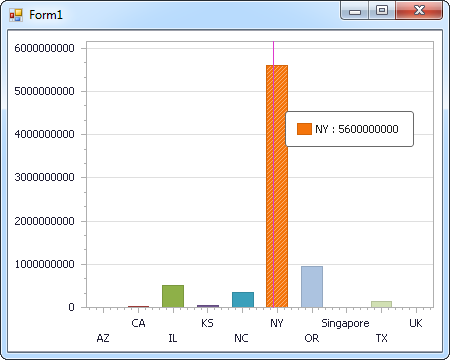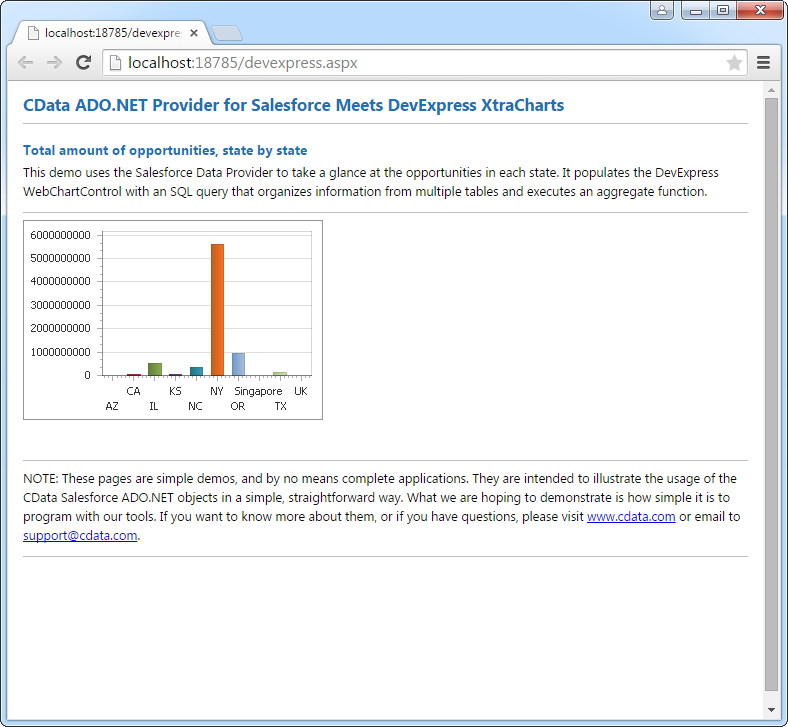Discover how a bimodal integration strategy can address the major data management challenges facing your organization today.
Get the Report →DataBind Dynamics 365 Business Central Data to the DevExpress Data Grid
Use the CData ADO.NET Provider for Dynamics 365 Business Central with the DevExpress Windows Forms and Web controls to provide Dynamics 365 Business Central data to a chart.
The ADO.NET Provider for Dynamics 365 Business Central by CData incorporates conventional ADO.NET data access components compatible with third-party controls. You can adhere to the standard ADO.NET data binding procedures to establish two-way access to real-time data through UI controls. This article will demonstrate the utilization of CData components for data binding with DevExpress UI Controls (Windows Forms and Web controls), specifically binding to a chart that visualizes live data.
To authenticate to Dynamics 365 Business Central, you must provide the User and AccessKey properties.
To obtain the User and AccessKey values, navigate to the Users page in Dynamics 365 Business Central and then click on Edit. The User Name and Web Service Access Key values are what you will enter as the User and AccessKey connection string properties. Note that the User Name is not your email address. It is a shortened user name.
To connect to data, specify OrganizationUrl. If you have multiple companies in your organization, you must also specify the Company to indicate which company you would like to connect to. Company does not need to be specified if you have only one company.
Windows Forms Controls
The code below shows how to populate a DevExpress chart with Dynamics 365 Business Central data. The D365BusinessCentralDataAdapter binds to the Series property of the chart control. The Diagram property of the control defines the x- and y-axes as the column names.
using (D365BusinessCentralConnection connection = new D365BusinessCentralConnection(
"OrganizationUrl=https://myaccount.financials.dynamics.com/;")) {
D365BusinessCentralDataAdapter dataAdapter = new D365BusinessCentralDataAdapter(
"SELECT accountid, Name FROM Accounts", connection);
DataTable table = new DataTable();
dataAdapter.Fill(table);
DevExpress.XtraCharts.Series series = new DevExpress.XtraCharts.Series();
chartControl1.Series.Add(series);
series.DataSource = table;
series.ValueDataMembers.AddRange(new string[] { "Name" });
series.ArgumentScaleType = DevExpress.XtraCharts.ScaleType.Qualitative;
series.ArgumentDataMember = "accountid";
series.ValueScaleType = DevExpress.XtraCharts.ScaleType.Numerical;
chartControl1.Legend.Visibility = DevExpress.Utils.DefaultBoolean.False;
((DevExpress.XtraCharts.SideBySideBarSeriesView)series.View).ColorEach = true;
}

Web Controls
The code below shows how to populate a DevExpress Web control with Dynamics 365 Business Central data. The D365BusinessCentralDataAdapter binds to the Series property of the chart; the Diagram property defines the x- and y-axes as the column names.
using DevExpress.XtraCharts;
using (D365BusinessCentralConnection connection = new D365BusinessCentralConnection(
"OrganizationUrl=https://myaccount.financials.dynamics.com/;"))
{
D365BusinessCentralDataAdapter D365BusinessCentralDataAdapter1 = new D365BusinessCentralDataAdapter("SELECT accountid, Name FROM Accounts", connection);
DataTable table = new DataTable();
D365BusinessCentralDataAdapter1.Fill(table);
DevExpress.XtraCharts.Series series = new Series("Series1", ViewType.Bar);
WebChartControl1.Series.Add(series);
series.DataSource = table;
series.ValueDataMembers.AddRange(new string[] { "Name" });
series.ArgumentScaleType = ScaleType.Qualitative;
series.ArgumentDataMember = "accountid";
series.ValueScaleType = ScaleType.Numerical;
((DevExpress.XtraCharts.SideBySideBarSeriesView)series.View).ColorEach = true;
}







